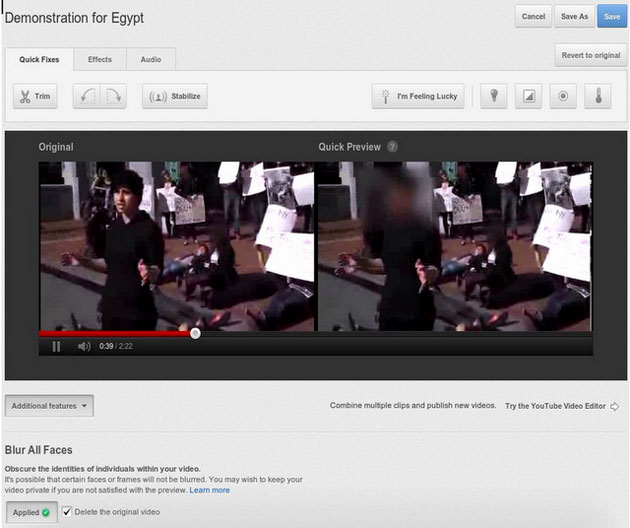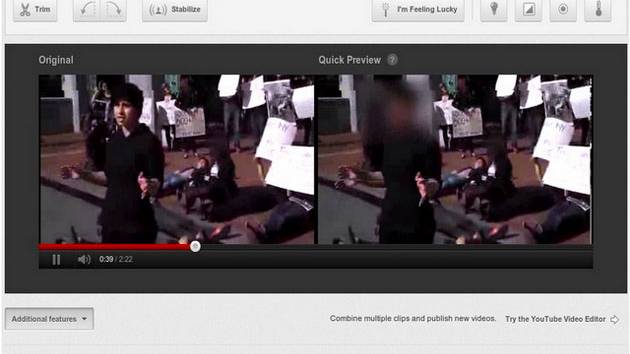Can You Trust YouTube’s ’Dissident Protecting’ Face-Blurring Tool?
 In what YouTube is calling a ’first step’ towards providing safety and security to activists and dissidents, the video-sharing website has launched a new tool that blurs faces in videos uploaded to its servers. Finally! Online anonymity - right?
In what YouTube is calling a ’first step’ towards providing safety and security to activists and dissidents, the video-sharing website has launched a new tool that blurs faces in videos uploaded to its servers. Finally! Online anonymity - right?Wrong. While it sounds like a very useful feature, how much can we truly trust that this is nothing more than a reassuring, yet misleading, concept?
Wired.com:
“Whether you want to share sensitive protest footage without exposing the faces of the activists involved, or share the winning point in your 8-year-old’s basketball game without broadcasting the children’s faces to the world, our face blurring technology is a first step towards providing visual anonymity for video on YouTube,” wrote Amanda Conway, a YouTube policy associate.

At present, the tool automatically blurs all faces detected by the facial recognition software when you’ve selected the option for the video you uploaded. YouTube users are calling for a more manual interface where they can blur individual faces, and leave others visible.
This isn’t a cure-all, however. Risks remain when uploading ANY content to the web. While this new tech might provide a degree of protection to protestors (both foreign and domestic), it is far from the safest option.
Some tips are provided on how to keep from being identified through your uploaded videos, from Google’s Public Policy Blog:
1. Assess your risk. You and the people you film may face risk by posting video online. You may risk your own safety and that of your subjects while filming sensitive footage, during the editing process, and when you distribute your film online. After assessing the vulnerability you and your subjects face, you can make more informed decisions about when to film, whether to distribute your footage, and how widely you want to share it.
2. Consider other information which may give away identity. Video footage of your face is not the only way someone can detect your identity. Other factors that may be caught on video can also identify you or your subjects. Watch out for vocal identifiers, like recognizable voices or saying someone’s name on camera. Other footage can give away identity like a license plate, a name tag, or even the background scenery. Make sure that the imagery in your videos does not give away information about your location or identity.
3. Protect yourself when uploading. Consider, for example, local laws that may allow authorities to track the mobile device from which you upload. In certain countries, merely purchasing a sim card puts users at risk of tracking by government.
Remember, however, that YouTube is owned by multinational corporation Google. Google doesn’t have a great track record of user data protection. Quite the opposite in fact! While Google warns against ’determined foes’ (ie: hackers or stalkers), Google itself is a primary source of information ’leaks’:
Did Google Hand a Wikileaks Volunteer’s Gmail Data to the U.S. Government?
Gmail users got a hefty dose of reality today when it was revealed that Google may have handed over one user’s private data to the U.S. government, who requested it without a search warrant.
The contacts list and IP address data of Jacob Appelbaum, a WikiLeaks volunteer and developer for Tor was requested by the U.S. government using a secret court order enabled by a controversial 1986 law called the Electronic Communications Privacy Act, according to the Wall Street Journal. The law allows the government to demand information from ISPs not only without a warrant, but without ever notifying the user.
Google Hands Over User Data For 94% Of U.S. Law Enforcement Requests
When law enforcement comes looking for evidence hidden in your Google search history, Gmail or the uncountable other Google services that touch many Internet users’ lives, don’t expect Google to turn the investigators away. In 19 out of 20 cases in the second half of last year, the company handed over at least some of the data the government demanded.
Google Admits Handing over European User Data to US Intelligence Agencies
Google has admitted complying with requests from US intelligence agencies for data stored in its European data centers, most likely in violation of European Union data protection laws.
Gordon Frazer, Microsoft UK’s managing director, made news headlines some weeks ago when he admitted that Microsoft can be compelled to share data with the US government regardless of where it is hosted in the world.
YouTube, although providing this convenient face-blurring tool, is simply harvesting personal info in other ways, and insisting it be accessible in the public sphere:
YouTube Fights Comment Trolls By Discouraging Pseudonyms
YouTube’s "secret weapon against the Internet’s worst commenters" has arrived: asking people to use their real name.
Site users noticed a new prompt over the weekend when they tried to make a comment on a YouTube video. The prompt asked them to publish their comment under their real name. The feature works by taking the potential commenter’s name from their Google+ profile.
In addition, many times when logging in to YouTube and Google accounts, users are prompted to provide a ’confirmable’ phone number and email address at which they can be reached. Between Google and YouTube, a user’s real name, real phone number, real cell number, real location and other personal data are all available to those who want them.
But what about uploading videos to the system, so that you can edit them with the new ’blurring’ feature? Can YouTube/Google be trusted to delete the original source video, even if you click "delete original"?
Google’s very own privacy policy states:
We aim to maintain our services in a manner that protects information from accidental or malicious destruction. Because of this, after you delete information from our services, we may not immediately delete residual copies from our active servers and may not remove information from our backup systems.
In the end, it might be wiser to perform any face blanking while offline, on one’s own computer, when real anonymity is needed.
The new YouTube blur option can be found in Video Enhancements Tool under additional features, if you trust that it will keep you and yours safe.
By Elizabeth Leafloor , RedIceCreations.com
Source Articles:
Official YouTube Blog
Google Public Policy Blog
Google Privacy Policy (2012)
Wired.com






















